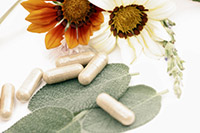Complementary Therapies
At New York Homeopathy, we employ a number of additional natural healing modalities in the pursuit of health and well-being. These additional approaches can be employed as supportive therapies in conjunction with homeopathy or as stand alone systems in a given case.
 Iridology
Iridology
Iridology is the science and art of observing marks or signs in the iris that occur as reflex responses to specific tissue conditions in the body. These markings represent a detailed picture of the integrity of various organs and systems of the body.
Information from each organ is transmitted by nerve connections and terminates in the corresponding sector of the right or left iris. When a particular organ or body system is morbid or out of balance, it registers a mark that can be seen upon magnification. Nature has provided an invaluable window into the vital status of the health of the body through the eyes.
Iridology has a history of over 125 years and developed through direct clinical experience of medical professionals. Through the dedication of generations of medical professionals and health practioners, today we have detailed “maps” of the irides. Qualified iridologists can view the actual health of the body through the eyes. We offer iridology as a helpful indicator into the “interior” health of the body.
 Herbal Remedies
Herbal Remedies
An herb is a plant or plant part used for its scent, flavor or therapeutic properties. Therapeutic, or medicinal, herbs have been used for thousands of years; in Chinese Medicine, in Ayurvedic Medicine, and by native cultures around the world. Herbs were also the foundation of much of modern medicine. Through many years of scientific research into the active ingredients of plant “remedies,” a wide range of potent drugs were developed – Aspirin came from Willow Bark; digoxin for heart failure from the Foxglove; steroids from the Wild Yam; anti-leukemia drugs vinblastine and vincristine from the Madagascan Periwinkle, to name a few.
Medicinal herbs offer a wide range support for holistic health and healing, helping the body to deal with dis-eased states and conditions. Some of the applications are: help the body to rid itself of unhealthy toxins; stimulate organ regeneration and vitality, manage inflammation, balance body chemistry, calm the nervous system. Medicinal herbs are safe and gentle under the guidance of an educated practitioner.
 Flower Essences
Flower Essences
Flower Essences are derived from flowers, yet they are different from herbal medicine or aromatherapy. These “remedies” have application to specific states of mind and emotion. They do not address physical illness directly, rather they seek to restore harmony to the mind to allow the body’s natural defenses to work more easily.
The developer of these remedies was a physician named Edward Bach. He spent the last years of his life researching the healing properties of flower essences. He identified 38 substances in all and grouped them into categories for application. These substances are used primarily to address states of mind.
Dr. Bach named seven broad categories of human emotion in which to group the 38 flower essences. The seven categories are: for fear; for uncertainty; for insufficient interest in present circumstances; for loneliness; for those over-sensitive to influences and ideas; for despondency or despair; for the over-care for welfare of others. Under these seven categories, he established a beautiful system to manage the wide range of unhealthy states of mind. Each remedy has a clear and unique application picture within its category, making the overall system broad and user-friendly.
 Sign up for periodic news and tips from New York Homeopathy
Sign up for periodic news and tips from New York Homeopathy